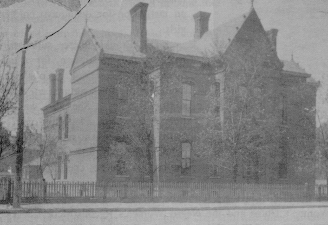On September 25, 1884, Nashville's last Negro city councilman of the era, James C. Napier, persuaded the council to adopt a resolution to provide high-school classes for Negro citizens. The Board of Education did not act on the resolution until 1886, when Mrs. Sandy Porter attempted to enroll her son, James Rice Porter, in the all-white public Fogg High School. The city's refusal to admit James and other Negro youths to the city's only high school forced the Negro community to hold mass meetings. A mass meeting held on September 14, 1886, at Clark Chapel Methodist Episcopal Church petitioned the Board of Education "to as speedily as possible consummate permanent high school facilities for the rapidly growing [population of] colored youth...."
The Board convened a special meeting and authorized the superintendent to establish ninth- and tenth-grade classes at the black Meigs Public School. Principal D. N. Crosthwaite, a black college graduate with bachelor's and master's degrees, received the task of implementing the classes. Crosthwaite was joined by teachers J. Ira Watson, J. M. Turpin, and L. T. Jackson. On September 20, 1886, Meigs became Nashville's first black high school. Eleventh-grade instruction was added to the school's curricula the following year.
Beginning during the 1897-98 academic year, the high-school department at Meigs was transferred to Pearl. On June 2, 1898, Pearl's first high-school class was graduated. Because of overcrowded conditions, the mayor and the city authorized the building of a new facility for Pearl High School. In 1917, Pearl moved to a new three-story structure at Sixteenth Avenue, North, and Grant Street. The Board hired additional teachers, expanded the course of study, and included a twelfth grade. The old Pearl building was renamed Cameron Junior High School, in honor of former teacher H. H. Cameron, who died during World War One.
By 1936, because of crowded conditions, it was necessary to begin construction of a new building. Located on Seventeenth Avenue, North, and Jo Johnston, the new structure was designed by the
 black
architectural firm of McKissack and McKissack. In the fall of 1937, students
moved into what "eminent authorities considered one of the most modern,
best constructed, and well-equipped buildings for Negroes in the South."
The city later added other facilities: vocational wing (1945), stadium
(1948), gymnasium, cafeteria, and four classrooms (1964). Pearl students
won many awards and athletic championships, including the 1966 TSSAA State
Basketball Championship.
black
architectural firm of McKissack and McKissack. In the fall of 1937, students
moved into what "eminent authorities considered one of the most modern,
best constructed, and well-equipped buildings for Negroes in the South."
The city later added other facilities: vocational wing (1945), stadium
(1948), gymnasium, cafeteria, and four classrooms (1964). Pearl students
won many awards and athletic championships, including the 1966 TSSAA State
Basketball Championship.
In 1983, the city's federal desegregation plan combined Pearl High School and West Nashville's predominantly white Cohn High School into the new Pearl-Cohn Comprehensive High School. The city built the Pearl-Cohn facility on the former sites of two black schools-Washington Junior High School and Ford Greene Elementary School--in North Nashville and converted the old Pearl High School facility into the Martin Luther King, Jr., Magnet School. In October of 1992, the Tennessee Historical Commission approved the placement of a historical marker at the site of the former Pearl High School.